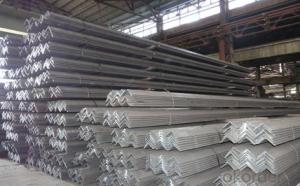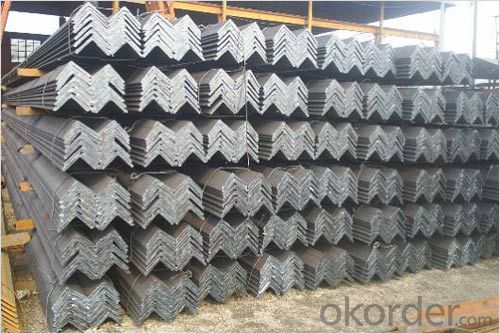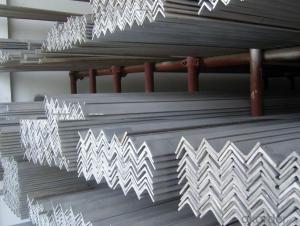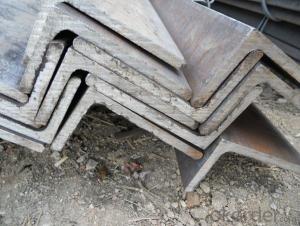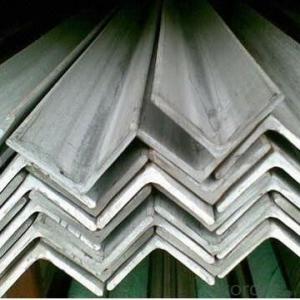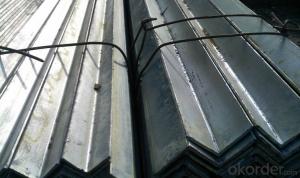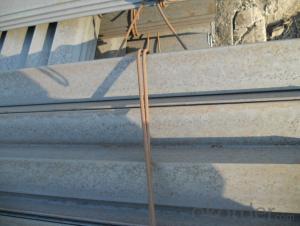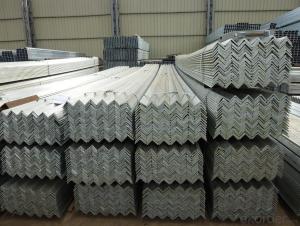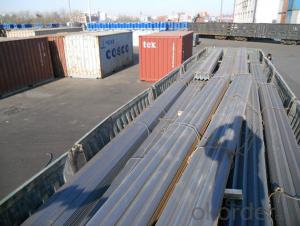Equal Angle Steel for Furniture and Super-market Shelf for Sale
- Loading Port:
- Tianjin
- Payment Terms:
- TT or LC
- Min Order Qty:
- 30 m.t.
- Supply Capability:
- 37000 m.t./month
OKorder Service Pledge
OKorder Financial Service
You Might Also Like
Product Description:
OKorder is offering Equal Angle Steel for Furniture and Super-market Shelf for Sale at great prices with worldwide shipping. Our supplier is a world-class manufacturer of steel, with our products utilized the world over. OKorder annually supplies products to European, North American and Asian markets. We provide quotations within 24 hours of receiving an inquiry and guarantee competitive prices.
Product Applications:
Equal Angle Steel for Furniture and Super-market Shelf for Sale are ideal for structural applications and are widely used in the construction of buildings and bridges, and the manufacturing, petrochemical, and transportation industries.
Product Advantages:
OKorder's Equal Angle Steel for Furniture and Super-market Shelf for Sale are durable, strong, and resist corrosion.
Main Product Features:
· Premium quality
· Prompt delivery & seaworthy packing (30 days after receiving deposit)
· Corrosion resistance
· Can be recycled and reused
· Mill test certification
· Professional Service
· Competitive pricing
Packaging & Delivery:
Packaging Detail: products are packed in bundle and then shipped by container or bulk vessel, deformed bar is usually naked strapping delivery, when storing, please pay attention to moisture proof. The performance of rust will produce adverse effect.
Each bundle weight: 2-3MT, or as required
Payment term: TT or L/C
Delivery Detail: within 45 days after received advanced payment or LC.
Label: to be specified by customer, generally, each bundle has 1-2 labels
Trade terms: FOB, CFR, CIF
FAQ:
Q1: Why buy Materials & Equipment from OKorder.com?
A1: All products offered byOKorder.com are carefully selected from China's most reliable manufacturing enterprises. Through its ISO certifications, OKorder.com adheres to the highest standards and a commitment to supply chain safety and customer satisfaction.
Q2: How do we guarantee the quality of our products?
A2: We have established an advanced quality management system which conducts strict quality tests at every step, from raw materials to the final product. At the same time, we provide extensive follow-up service assurances as required.
Q3: How soon can we receive the product after purchase?
A3: Within three days of placing an order, we will begin production. The specific shipping date is dependent upon international and government factors, but is typically 7 to 10 workdays.
Images:
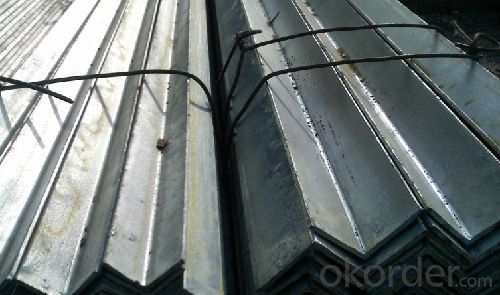
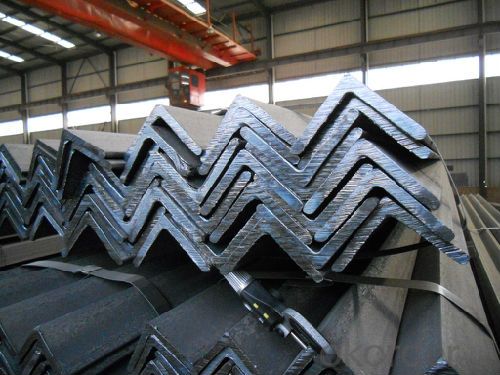
- Q: How do steel angles compare to aluminum angles?
- Different applications require different materials, with steel angles and aluminum angles having distinct properties and characteristics. Steel angles, also referred to as steel L-shaped beams, are known for their robustness and resilience. They find extensive use in construction projects like building frames, bridges, and industrial structures where their ability to bear heavy loads is essential. Comparatively, steel angles possess a higher tensile strength than their aluminum counterparts, allowing them to withstand greater forces without deformation or breakage. On the contrary, aluminum angles are lightweight and possess exceptional corrosion resistance. This makes them ideal for applications where weight is a crucial factor, such as the aerospace and marine industries. Additionally, aluminum angles are commonly employed in architectural projects due to their malleability and ability to be shaped into various designs. Furthermore, aluminum angles exhibit commendable thermal and electrical conductivity properties, making them well-suited for heat transfer applications. When it comes to cost, steel angles are generally more budget-friendly due to lower steel production costs. However, aluminum angles often demand less maintenance and boast a longer lifespan, thanks to their resistance against corrosion. Ultimately, the selection between steel angles and aluminum angles is contingent upon the specific requirements of the project. If the priority is high strength and durability, steel angles are the preferred option. Conversely, if weight, corrosion resistance, and design flexibility hold greater importance, aluminum angles are the superior choice.
- Q: How do steel angles perform in terms of vibration resistance?
- Due to their robust and inflexible structure, steel angles generally exhibit excellent vibration resistance. The L-shaped configuration of a steel angle not only enhances its strength and stability but also grants it heightened resistance to vibrations. When utilized in construction or engineering endeavors, steel angles effectively absorb and mitigate vibrations, thereby minimizing the potential for structural damage or failure. The rigidity and notable tensile strength of steel angles enable them to withstand dynamic loads and vibrations stemming from diverse factors, such as wind, earthquakes, or machinery operations. They proficiently distribute and dissipate vibrational forces throughout their structure, averting excessive movement or oscillation. This proves particularly pivotal in applications requiring steadfastness and longevity, such as in the construction of bridges, buildings, or industrial equipment. Furthermore, steel angles can be tailored and fabricated to meet precise vibration resistance specifications. By selecting suitable steel grades and dimensions, engineers can optimize the performance of steel angles in terms of vibration resistance. They also possess the ability to incorporate supplementary characteristics like stiffeners or reinforcements, further augmenting the vibration resistance of steel angle structures. Collectively, steel angles have demonstrated their dependability and effectiveness in withstanding vibrations, rendering them a favored choice across a multitude of industries and applications where upholding structural integrity is of paramount importance.
- Q: What are the advantages of using steel angles in manufacturing?
- Using steel angles in manufacturing offers several advantages. Firstly, steel angles possess immense strength and durability, making them suitable for a wide array of applications. They are capable of withstanding heavy loads and providing structural stability, making them an ideal choice for the construction of buildings, bridges, and other infrastructure projects. Secondly, steel angles provide versatility in terms of design. They can be easily customized and fabricated into different shapes and sizes, allowing manufacturers to create products that meet specific requirements. Whether it be a simple bracket or a complex framework, steel angles can be adapted to fit any desired design. Furthermore, steel angles exhibit excellent resistance to corrosion. They can endure exposure to moisture, chemicals, and other environmental factors, making them suitable for outdoor applications and industries where corrosion poses a concern. Another advantage of utilizing steel angles is their cost-effectiveness. Steel is a relatively inexpensive material compared to alternatives such as aluminum or stainless steel. Moreover, steel angles have a long lifespan, requiring minimal maintenance and replacement, thus reducing overall costs in the long term. Lastly, steel angles are readily available in the market. They can be easily obtained from steel suppliers, ensuring accessibility for manufacturers worldwide. In conclusion, the utilization of steel angles in manufacturing grants advantages in terms of strength, versatility, corrosion resistance, cost-effectiveness, and availability. These factors make steel angles the preferred choice for various industries, enabling them to produce high-quality, durable, and cost-efficient products.
- Q: What's the size of the 50 angle iron?
- Specification for 50 equal anglesTwo sides at right angles, 90 degrees. The length of the side is 50mm, and the thickness of the edge is 3mm, 4mm, 5mm and 6mm. The corresponding weight of each meter is 2.332 kg, 3.059 kg, 3.770 kg, 4.465 kg, respectively, four kg.
- Q: What are the different types of steel angles connections for trusses?
- For trusses, there exists a variety of steel angle connections, each with its own advantages and applications. 1. Bolted Connections: These connections, widely used for trusses, involve joining the steel angles together using bolts. They offer a secure and robust connection, while also being easy to install and disassemble if necessary. Bolted connections are often employed in situations where trusses need to be transported or assembled on-site with convenience. 2. Welded Connections: This type of connection involves fusing the steel angles together using heat and pressure, resulting in a permanent and strong connection. Welded connections are particularly suitable for heavy-duty truss applications, offering excellent load-bearing capacity. They are commonly utilized in structures that require high strength and rigidity. 3. Gusset Plate Connections: In this method, a gusset plate, made of steel, is employed to connect the steel angles together. The gusset plate is usually bolted or welded to the steel angles, providing a secure connection. This type of connection is commonly utilized when the angles need to be connected at angles other than 90 degrees. 4. Clip Connections: Clip connections utilize metal clips to join the steel angles together. These clips are typically bolted or welded to the steel angles, creating a strong and secure connection. Clip connections are often used for trusses that require a flush connection at a 90-degree angle. 5. Cleat Connections: Cleat connections involve the use of a metal plate, called a cleat, to connect the steel angles together. The cleat is typically bolted or welded to the steel angles, providing a sturdy connection. Cleat connections are commonly used for trusses that require additional reinforcement and a 90-degree angle connection. In conclusion, the selection of a steel angle connection for trusses depends on the specific requirements of the structure, such as load-bearing capacity, ease of installation, and desired strength and rigidity. To determine the most suitable connection type for a particular application, it is recommended to consult with a structural engineer or truss manufacturer.
- Q: What are the common surface treatments for steel angles?
- There are several common surface treatments for steel angles, depending on the desired application and level of corrosion resistance required. Some of the most common surface treatments include: 1. Hot-dip galvanizing: This process involves immersing the steel angles in a bath of molten zinc, which forms a protective layer on the surface. Hot-dip galvanizing provides excellent corrosion resistance and is commonly used in outdoor applications. 2. Powder coating: Powder coating involves applying a dry powder to the surface of the steel angles, which is then cured under heat to form a protective and decorative coating. Powder coating is highly durable and provides good corrosion resistance, making it suitable for both indoor and outdoor applications. 3. Paint: Painting steel angles is a cost-effective and versatile surface treatment option. The steel angles are typically primed with a rust-inhibiting primer and then painted with a suitable topcoat. Paint provides a decorative finish and some level of corrosion resistance, although it may not be as long-lasting as other treatments. 4. Electroplating: Electroplating is a process where a thin layer of metal, such as zinc or chrome, is deposited onto the surface of the steel angles using an electric current. This treatment provides both corrosion resistance and aesthetic appeal, making it suitable for various applications. 5. Anodizing: Anodizing is typically used for aluminum, but it can also be applied to steel angles. This process involves creating an oxide layer on the surface of the metal, which provides corrosion resistance and improved durability. Anodizing can also provide a decorative finish and is commonly used in architectural applications. It's important to note that the choice of surface treatment for steel angles depends on factors such as the intended use, budget, and environmental conditions. Consulting with professionals or experts in the field can help determine the most suitable surface treatment for a specific application.
- Q: How do steel angles perform in terms of fire resistance?
- Steel angles have good fire resistance properties due to their high melting point and low thermal conductivity. They can withstand high temperatures for a longer time compared to other materials, such as wood or aluminum. However, it is important to note that the fire resistance of steel angles can be affected by factors such as the thickness of the steel, fire protection measures, and the duration of exposure to fire.
- Q: What are the weight per meter calculations for steel angles?
- The weight per meter calculations for steel angles depend on the dimensions of the angle and the density of the steel being used. To calculate the weight per meter of a steel angle, you need to know the dimensions of the angle, specifically the thickness, width, and length. The formula to calculate the weight per meter is: Weight per meter = (Thickness x Width x Length) x Density The density of steel varies depending on the type of steel being used. The most common type of steel used for angles is mild steel, which has a density of approximately 7.85 grams per cubic centimeter (g/cm³) or 7850 kilograms per cubic meter (kg/m³). For example, let's say we have a steel angle with a thickness of 10 millimeters (mm), a width of 100 mm, and a length of 1 meter (1000 mm). Using the formula and assuming a density of 7850 kg/m³, the weight per meter would be: Weight per meter = (10 mm x 100 mm x 1000 mm) x 7850 kg/m³ Weight per meter = 10,000,000 mm³ x 7850 kg/m³ Weight per meter = 78,500,000,000 mm³/kg To convert the weight to a more common unit, we can divide by 1,000,000 to get the weight per meter in kilograms: Weight per meter = 78,500,000,000 mm³/kg / 1,000,000 Weight per meter = 78,500 kg/m Therefore, the weight per meter of this steel angle would be 78,500 kilograms.
- Q: What are the design considerations for incorporating steel angles into a structure?
- When incorporating steel angles into a structure, several design considerations need to be taken into account. First and foremost, the load-bearing capacity of the steel angles must be carefully assessed to ensure they can support the intended loads. The dimensions and thickness of the angles should be determined based on the structural requirements and anticipated stress levels. Additionally, the connection details between the steel angles and other structural elements need to be carefully designed to ensure they provide sufficient strength and rigidity. Considerations should include the type of fasteners, welding techniques, and any additional reinforcement required to achieve the desired structural integrity. Furthermore, factors such as corrosion protection, fire resistance, and durability should also be considered during the design process. Appropriate measures should be taken to prevent rust and corrosion on the steel angles, such as applying protective coatings or using stainless steel. Fire-resistant coatings or fireproofing materials may also be necessary, depending on the building's fire safety requirements. Lastly, aesthetics and architectural considerations may come into play when incorporating steel angles into a structure. The design should take into account the desired visual appearance, whether the angles will be exposed or concealed, and how they will integrate with the overall architectural style. In conclusion, the design considerations for incorporating steel angles into a structure involve assessing load-bearing capacity, connection details, corrosion protection, fire resistance, durability, and aesthetic integration.
- Q: Can steel angles be used in fencing?
- Indeed, fencing can make use of steel angles. Steel angles find frequent application in fencing scenarios, serving to furnish structural reinforcement and stability. Their utility ranges from functioning as posts to serving as crossbars, contingent upon the particular design of the fencing. Steel angles possess robustness and durability, rendering them well-suited for enduring various elements whilst guaranteeing security. Through facile welding or bolting, steel angles can effortlessly be conjoined to construct a resilient fencing structure. Furthermore, steel angles can be galvanized or coated, augmenting their resistance to rust and corrosion, thereby securing a fencing solution that endures for a prolonged period with minimal maintenance.
Send your message to us
Equal Angle Steel for Furniture and Super-market Shelf for Sale
- Loading Port:
- Tianjin
- Payment Terms:
- TT or LC
- Min Order Qty:
- 30 m.t.
- Supply Capability:
- 37000 m.t./month
OKorder Service Pledge
OKorder Financial Service
Similar products
Hot products
Hot Searches
Related keywords
